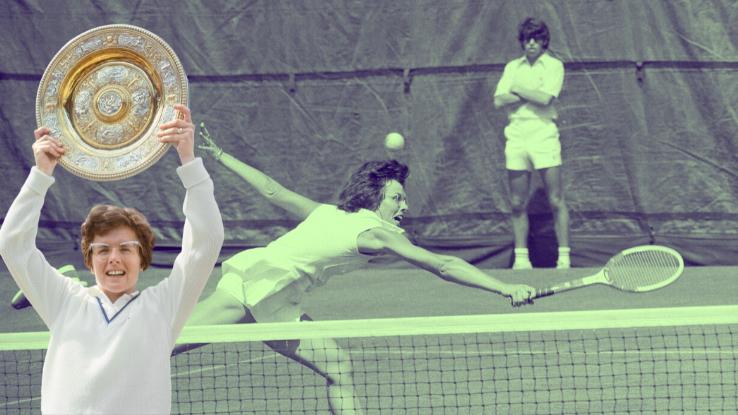To Wimbledon and Back: The History of Grand Slam Tournaments

When it comes to the most sought-after championships in tennis, players dream of competing at the four Grand Slam tournaments from a young age. The Australian Open, French Open, Wimbledon and U.S. Open each present players with unique challenges — and while players compete throughout the season in a variety of tournaments, winning even one of the Grand Slams will cement their place in tennis history.
Steeped in tradition, the history of Grand Slam tournaments is what makes them so coveted. Before the U.S. Open kicks off this year in New York, delve into the history of these prestigious tournaments with us.
What Is a Grand Slam in Tennis?
In tennis, the four Grand Slam tournaments — the Australian Open, the French Open, Wimbledon and the U.S. Open — are also referred to as majors. Since the tournaments offer the most prize money, media attention and ranking points, they are considered the most important and prestigious tennis events of the year. Moreover, the term “Grand Slam” refers to an accomplishment, too. That is, a Grand Slam is also when a player wins all four of the major championships in the same calendar season.
Without a doubt, it’s most challenging to achieve a calendar-year Grand Slam since it requires four consecutive wins, starting with the Australian Open and finishing with the U.S. Open. However, some players have been recognized for achieving a non-calendar year Grand Slam, meaning they win four consecutive tournaments over two seasons (or calendar years). For example, if a player wins Wimbledon and the U.S. Open in one season and then goes on to win the Australian Open and French Open in the new year, that’s a non-calendar year Grand Slam.

This feat was nicknamed the “Serena Slam,” after tennis legend Serena Williams won four consecutive Grand Slam titles between 2002 and 2003. In the wake of Williams’ second “Serena Slam,” Bustle noted that the 23-time Grand Slam singles champ has never managed to “net all of them in the same calendar year,” writing that the feat has “only been accomplished by three women in the history of tennis — American Maureen Connolly Brinker in 1953, Australian Margaret Court in 1970, and German Steffi Graf in 1988.” (Still, when tennis lingo takes on your name, you know you’re the GOAT.)
Finally, a career Grand Slam is when a player wins all four tournaments at any point during their career, without considering the order in which they won them or even at what point in their career they won each championship.
The Four Grand Slams of Tennis
Australian Open
The first Grand Slam event of the calendar year is the Australian Open, which is held in Melbourne in January. The tournament features men’s and women’s singles and doubles, mixed doubles, and wheelchair tennis. First played in 1905, the Grand Slam event found its permanent home in 1988 at Flinders Park in Melbourne (later changed to Melbourne Park in 1996).
It has since seen its Centre Court renamed after tennis legend Rod Laver, who was ranked No. 1 between 1964 to 1970 — an impressive span! — and, on the men’s side, he’s one of two players who can claim to win calendar-year Grand Slams (1962 and 1969). Additionally, Margaret Court Arena was named after the controversial Margaret Court, who won three calendar-year Grand Slam titles — one in singles and two in mixed doubles — though many believe the area should be renamed due to Court’s long-held, bigoted views.
French Open
Also known as Roland Garros, the French Open commences in Paris, France at the end of May. As such, it’s the second major event on the calendar. As the only Grand Slam event played on a clay court, the tournament was originally only open to French tennis clubs. But with competition rising, player eligibility was opened more broadly after the tournament was designated as one of the Big Four tournaments in 1925.
Although the French Open started as a one-day National Championship, the French Tennis Federation built a brand new stadium on three hectares of land following the French win over the U.S. in the Davis Cup in 1927, eager to make more of an event out of the tournament. In an interesting twist, the new stadium was named Roland Garros in honor of the French aviator who, in 1913, became the first man to make a non-stop flight across the Mediterranean Sea.
Last year, the French Open came under fire after four-time Grand Slam champ Naomi Osaka spoke out about her mental health and her decision to not partake in the tournament-mandated press circuit. “I’m writing this to say I’m not going to do any press during Roland Garros,” she wrote, per British Vogue. “I’ve often felt that people have no regard for athletes’ mental health and this rings true whenever I see a press conference or partake in one.” In the wake of Osaka’s decision, the Roland Garros referee fined her $15,000, citing that it was only fair to the other players to do so. Understandably, Osaka dropped out of the tournament and, online, she received a huge swell of support from fans, fellow athletes, and mental health advocates, many of whom called for a boycott of the French Open.

Wimbledon
Perhaps the most prestigious of the Grand Slam events, Wimbledon is commonly referred to as “The Championships.” The oldest tennis championship tournament in history, it’s held in London, England, and dates back to 1877. Starting in late June and continuing into early July, Wimbledon is the only tournament to take place on a grass court. Moreover, a strict dress code requires players to wear all-white attire to compete.
Due to the COVID-19 pandemic, The Championships were canceled in 2020 — the first time Wimbledon hadn’t gone on as scheduled since World War II. Many players, including Roger Federer, have publicly stated that winning Wimbledon is the most prestigious achievement one can attain. This year, before she retired from The Championships due to injury, Serena Williams spoke about returning to the Grand Slam after its 2020 cancellation. “It’s a little different walking the Grounds now,” Williams told the press. “Wimbledon, in general, feels a lot different, but it still has a very special feeling.”
U.S. Open
The last of the four Grand Slam tournaments held during the calendar year is the U.S. Open, which takes place at the end of August at the Billie Jean King National Tennis Center in Flushing Meadows — a neighborhood in New York’s Queens borough. The tennis center takes its name from Billie Jean King, one of the greatest tennis players in history. Notably, King won a total of 29 Grand Slam titles — 12 of which were singles wins — and, as part of the “Original 9,” founded the Women’s Tennis Association (WTA) in 1973.
In addition to the men’s and women’s singles and doubles, mixed doubles, and wheelchair tennis, the tournament also sees competition in the junior and senior divisions. The tournament stems from the U.S. National Championship, which was first played in 1881. But since 1968 the prestigious hard-court tournament has been known as the U.S. Open. If a player is poised to achieve a calendar-year Grand Slam, the U.S. Open is, of course, a rather exciting watch.
While players compete in many different international tournaments throughout the calendar year, the four Grand Slam events are by far the most coveted and hardest to win. Winning just one of the majors cements a player’s place in tennis history — but winning all four earns them legendary status.





